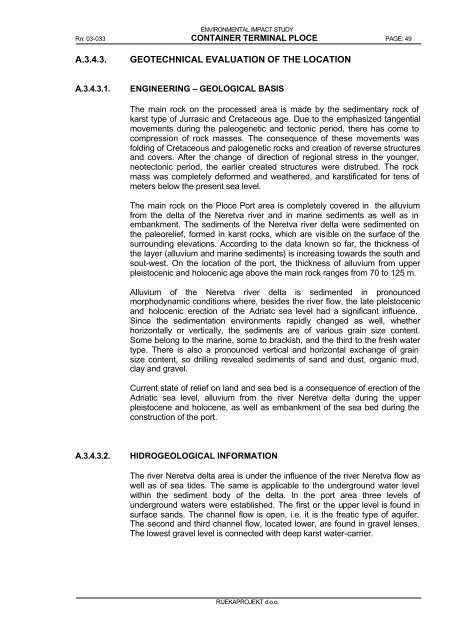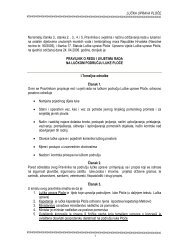HEADING PAGE - port of ploce authority * welcome
HEADING PAGE - port of ploce authority * welcome
HEADING PAGE - port of ploce authority * welcome
Create successful ePaper yourself
Turn your PDF publications into a flip-book with our unique Google optimized e-Paper software.
ENVIRONMENTAL IMPACT STUDY<br />
Rn: 03-033 CONTAINER TERMINAL PLOCE <strong>PAGE</strong>: 49<br />
A.3.4.3. GEOTECHNICAL EVALUATION OF THE LOCATION<br />
A.3.4.3.1. ENGINEERING – GEOLOGICAL BASIS<br />
The main rock on the processed area is made by the sedimentary rock <strong>of</strong><br />
karst type <strong>of</strong> Jurrasic and Cretaceous age. Due to the emphasized tangential<br />
movements during the paleogenetic and tectonic period, there has come to<br />
compression <strong>of</strong> rock masses. The consequence <strong>of</strong> these movements was<br />
folding <strong>of</strong> Cretaceous and palogenetic rocks and creation <strong>of</strong> reverse structures<br />
and covers. After the change <strong>of</strong> direction <strong>of</strong> regional stress in the younger,<br />
neotectonic period, the earlier created structures were distrubed. The rock<br />
mass was completely deformed and weathered, and karstificated for tens <strong>of</strong><br />
meters below the present sea level.<br />
The main rock on the Ploce Port area is completely covered in the alluvium<br />
from the delta <strong>of</strong> the Neretva river and in marine sediments as well as in<br />
embankment. The sediments <strong>of</strong> the Neretva river delta were sedimented on<br />
the paleorelief, formed in karst rocks, which are visible on the surface <strong>of</strong> the<br />
surrounding elevations. According to the data known so far, the thickness <strong>of</strong><br />
the layer (alluvium and marine sediments) is increasing towards the south and<br />
sout-west. On the location <strong>of</strong> the <strong>port</strong>, the thickness <strong>of</strong> alluvium from upper<br />
pleistocenic and holocenic age above the main rock ranges from 70 to 125 m.<br />
Alluvium <strong>of</strong> the Neretva river delta is sedimented in pronounced<br />
morphodynamic conditions where, besides the river flow, the late pleistocenic<br />
and holocenic erection <strong>of</strong> the Adriatc sea level had a significant influence.<br />
Since the sedimentation environments rapidly changed as well, whether<br />
horizontally or vertically, the sediments are <strong>of</strong> various grain size content.<br />
Some belong to the marine, some to brackish, and the third to the fresh water<br />
type. There is also a pronounced vertical and horizontal exchange <strong>of</strong> grain<br />
size content, so drilling revealed sediments <strong>of</strong> sand and dust, organic mud,<br />
clay and gravel.<br />
Current state <strong>of</strong> relief on land and sea bed is a consequence <strong>of</strong> erection <strong>of</strong> the<br />
Adriatic sea level, alluvium from the river Neretva delta during the upper<br />
pleistocene and holocene, as well as embankment <strong>of</strong> the sea bed during the<br />
construction <strong>of</strong> the <strong>port</strong>.<br />
A.3.4.3.2. HIDROGEOLOGICAL INFORMATION<br />
The river Neretva delta area is under the influence <strong>of</strong> the river Neretva flow as<br />
well as <strong>of</strong> sea tides. The same is applicable to the underground water level<br />
within the sediment body <strong>of</strong> the delta. In the <strong>port</strong> area three levels <strong>of</strong><br />
underground waters were established. The first or the upper level is found in<br />
surface sands. The channel flow is open, i.e. it is the freatic type <strong>of</strong> aquifer.<br />
The second and third channel flow, located lower, are found in gravel lenses.<br />
The lowest gravel level is connected with deep karst water-carrier.<br />
RIJEKAPROJEKT d.o.o.



